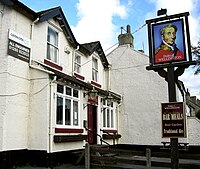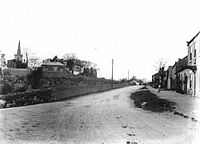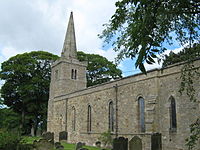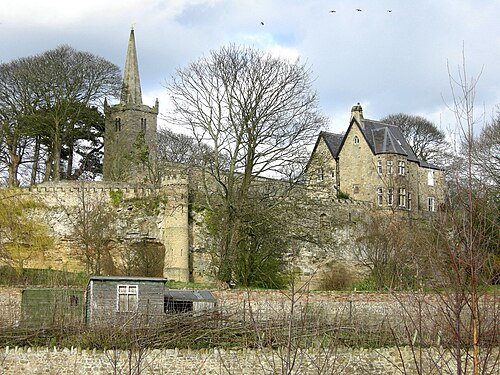Difference between revisions of "High Coniscliffe"
(Created page with "{{Infobox town |county=Durham |picture=High Coniscliffe 074.jpg |picture caption=Lychgate, High Coniscliffe |os grid ref=NZ226153 |latitude=54.53279 |longitude=-1.65211528 |na...") |
(No difference)
|
Latest revision as of 19:29, 18 September 2024
| High Coniscliffe | |
| County Durham | |
|---|---|
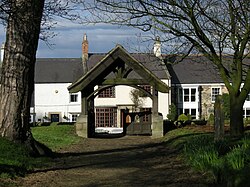 Lychgate, High Coniscliffe | |
| Location | |
| Grid reference: | NZ226153 |
| Location: | 54°31’58"N, 1°39’8"W |
| Data | |
| Population: | 242 (2011) |
| Post town: | Darlington |
| Postcode: | DL2 |
| Dialling code: | 01325 |
| Local Government | |
| Council: | Darlington |
| Parliamentary constituency: |
Darlington |
High Coniscliffe is a village in County Durham, on the north bank of the River Tees which marks the county's southern border. The wider civil parish includes Carlbury and Low Coniscliffe. At the 2011 Census the population of this civil parish was 242.
This is a linear village, with most houses along the north side of the A67, but is also a doubly nucleated village as it has a village green and church on the south side of the road, and a history of a community focus at the T-junction of Ulnaby Lane and the A67, where the Methodist church and post office once were, and where a public house remains. It has always been a small village, but its history goes back to Anglo-Saxon times, and the earliest part of St Oswald's church is Norman.
The local pub, The Duke of Wellington, had a portrait of Napoleon, Wellington's defeated enemy, on its sign from 1975 to 1988.
History
Æthelwald Moll of Northumbria, who may have previously murdered King Oswulf for the succession, killed Oswin, a Bernician nobleman here in 761. In the year 778 a high sheriff called Elduf was killed here. Later there was a coup in which Æthelred I of Northumbria, Moll's son, was driven out by Ælfwald I of Northumbria, and several royal nobles were killed in this same village.[1] Richard Thirkeld, a Romanist missionary priest from the village, was executed at York on 29 May 1583 for high treason. On 4 March 1590 another local Roman Catholic priest, Christopher Bayles, was similarly executed.
In 1734 the churchwardens of the village were given a house and six acres by Robert Bowes of Thornton Hall. The rent from the house was donated to the poor at Christmas and midsummer. A venerable native of the village was carpenter Matthew Greathead (23 April 1770−31 December 1871), who became the oldest living Freemason of his time. His lodge commemorated him with a column at the gate of St Mary's church, Richmond.
A school was built here in 1830, and that building is now the church hall. A national school was founded in 1848 for 87 pupils. There is a local legend (set at the time when the national school was being built). It tells that a native man called Dickenson returned to his village on 28 June 1848 to attempt a cure for paralysis. He asked to be buried up to his neck in the riverbank for four hours, and after much pain his health was improved.
About the village
Smotherlaw barrow at Carlbury is in the parish of High Coniscliffe. A small, copper, Bronze Age tool was found in the village in 1991. Roman pottery, thought to be related to Piercebridge Roman Fort, has been found scattered on fields, possibly as fertiliser from a Roman midden.
There is a carving in St Edwin's church of two winged figures on either side of a calf or ram; this is thought to be an Anglo-Saxon re-carving of a Roman dedication stone.[2]
Old Hall Farm incorporates a farmhouse, at 23 The Green, whose north-west wing could be a 13th-century bastle house, built as sanctuary during raids from Scotland. Most of the building dates from the 17th century.
There are two local pubs: The Duke of Wellington and The Spotted Dog. The latter is named after a foxhound called Blue Cap which won a race at Newmarket for a wager with a stake of 500 guineas in 1792.[3]
The Duke of Wellington had a picture of Napoleon on its sign from 1975 to 1988.
Church
The parish church is dedicated to Edwin of Northumbria, who declared himself overking of all England and converted to Christianity on 11 April 627.[4]
It is thought that there could have been an earlier church on the site, but the present St Edwin's church dates from 1170. It is built of limestone, with a Norman carved and arched doorway under the north porch. It has a nave, chancel, north aisle, square tower and octagonal spire. The embattled tower was built in the Middle Ages. The chancel arch is Gothic.
Outside links
| ("Wikimedia Commons" has material about High Coniscliffe) |
References
- ↑ "Brnard Cornwell". History of Northumbria: Anglo-Saxon Era. 17 August 2009. http://bernardcornwellbookgroup.blogspot.com/2009/08/history-of-northumbria-anglo-saxon-era.html.
- ↑ "Mediæval Archaeology". Index of Volumes XVI-XX, 1972–1976: vol 20 (1976), fig.47. London: The Society for Mediæval Archaeology. 1978. pp. 143. http://ads.ahds.ac.uk/catalogue/adsdata/arch-769-1/ahds/dissemination/pdf/indexes-vol01-45/016_020_001_058_index.pdf.
- ↑ Dave, Fox (11 April 2008). "The Blue Cap, Sandiway – Into the blue". Chester Chronicle. http://www.chesterchronicle.co.uk/entertainment-chester/restaurants-chester-cheshire/2008/04/11/the-blue-cap-sandiway-into-the-blue-59067-20761648/.
- ↑ Simpson, David (1991–2009). "Anglo-Saxon and Viking Northumbria (400–1066)". History of Northumbria: Anglo-Saxon era 450AD-866AD: Edwin's conversion to Christianity. http://www.englandsnortheast.co.uk/KingdomofNorthumbria.html.
